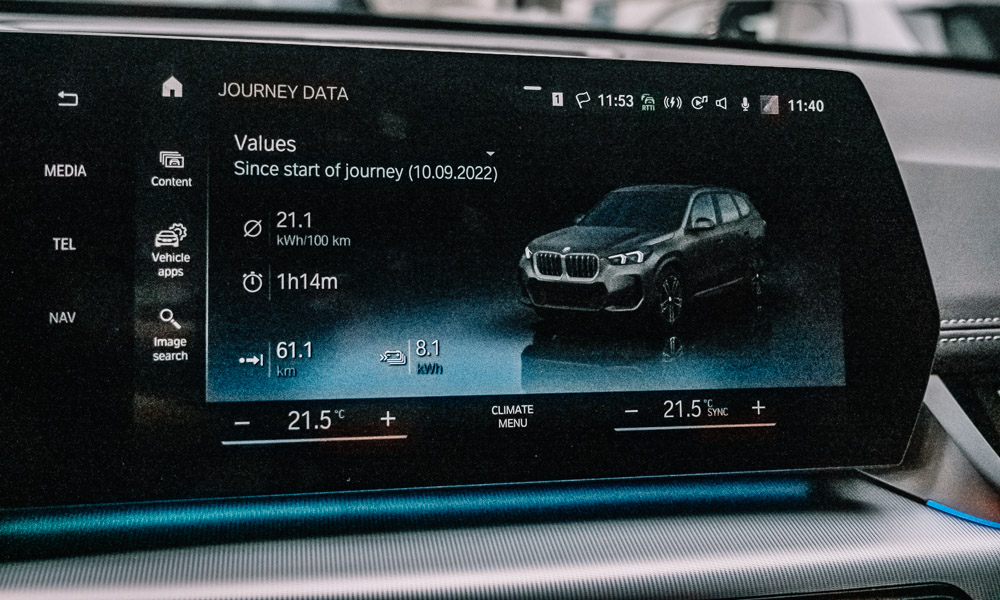
BMW currently has three electric SUVs (okay, Sports Activity Vehicles) in its lineup: the opinion-splitting iX flagship, the rather conservative iX3, and then the all-new iX1, which is arguably the most interesting of the trio.
It’s based on an all-new model, and it’s a compact SUV, meaning that a large number of people will be eyeing this as their first EV. So, while I was at its Regensburg Plant in Germany for the launch of the all-new X1, we were given the opportunity to drive several prototypes in a guided tour of the countryside and the famed autobahn.



For starters, the iX1 isn’t radically different compared to what a regular X1 looks like, save for the reduced boot capacity of 490L because of the batteries underneath.



This M Sport trim—finished in Frozen Gray and fitted with 20-inch wheels—looked identical inside and out, save for the blue-rimmed BMW logos and the subtle ‘i’ badging found within the grille and beside the model badge. Don’t forget the exclusive menus and options found only in the brand’s EVs.



Otherwise, it will have blue accents on the grille and lower bodywork on the Sport and xLine trims (which can be deleted as well if you want). Personally, I dig this configuration, but sadly, we weren’t allowed to take photos of the white iX1 on display within the plant.


For some housekeeping, the iX1 xDrive30 prototype I drove utilizes the Gen5 drivetrain and battery pack, which has two electric motors (the M170SF and the M170SR, to be exact) and a 64.7kWh battery.
The total system output is 313hp (with 494Nm), but you get an additional 40hp from the vehicle’s “Boost” mode. This propels the iX1 to 100km/h in 5.6 seconds, but the top speed is pegged at 180km/h.
The motors are mostly front-biased for the best possible range, but the rear motor can seamlessly kick in if the conditions need it. And speaking of range, we were quoted a figure of 414km to 440km depending on your wheel-and-tire selection.
And when it’s time to charge up, you have the option to use an 11kW mobile fast charger or a 22kW home charger. It also supports up to 130kW DC rapid charging, which can bring the battery from 10% to 80% in 29 minutes.


But boy, is it quick.
It feels like a rocket the moment you floor it. And the wave of instant torque hits you at the back of your head, with the rear end of the vehicle getting a little squirrelly all while a “cinematic” soundtrack composed by no less than Hans Zimmer himself blasts out of the vehicle’s speakers, which can be turned off if you prefer to listen to the sound of silence.
On our guided drive, we were shown windy back roads to throw the cars around. I fondly remember hearing our lead car telling us to “push it even harder” in the damp German countryside. The X1 is already a great-handling small SUV with the M Sport adaptive suspension, but the iX1’s lower center of gravity makes tossing it around corners at speed a joy, but you will feel the vehicle’s added weight.
And when it was time for us to hit the autobahn, using the “boost” mode was enough to propel the vehicle to 140km/h in a blink of an eye, which was intoxicating to use. But you might not want to use it as much as I did, as your range will take a hit.

And just like all EVs, the vehicle can regenerate energy by braking. This is where the various regeneration modes come in, which are Low, Moderate, High and Adaptive.
Simply put, these different modes control the amount of braking force from the electric motors to regenerate energy. But if you want to engage in one-pedal driving, put the car in “B” mode, and it’ll be in its most aggressive mode to recover as much energy as possible.
The Adaptive mode is interesting, because it not only allows the vehicle to coast like an ICE-powered vehicle, but it also recognizes traffic conditions and adapts the braking strength to the situation to give the most comfortable and ideal amount of regenerative braking. But my personal preference is Moderate, as it feels the closest to proper engine-braking in a manual-transmission vehicle.

There are other bits that I wasn’t able to test, like how the cooling system can predictively heat or cool the batteries when approaching a fast charger so you will get the benefits of the rapid charging right away, or how the navigation system can adapt and find charging stations along your route depending on your state of charge.
The automaker expects a huge chunk of the X1’s sales in its primary markets to be the iX1, which should be no surprise considering the direction of the automotive industry at the moment. While I can’t say whether the iX1 will even make it to our shores, it will be a great alternative for those who want a practical and small electric SUV from BMW.











Comments